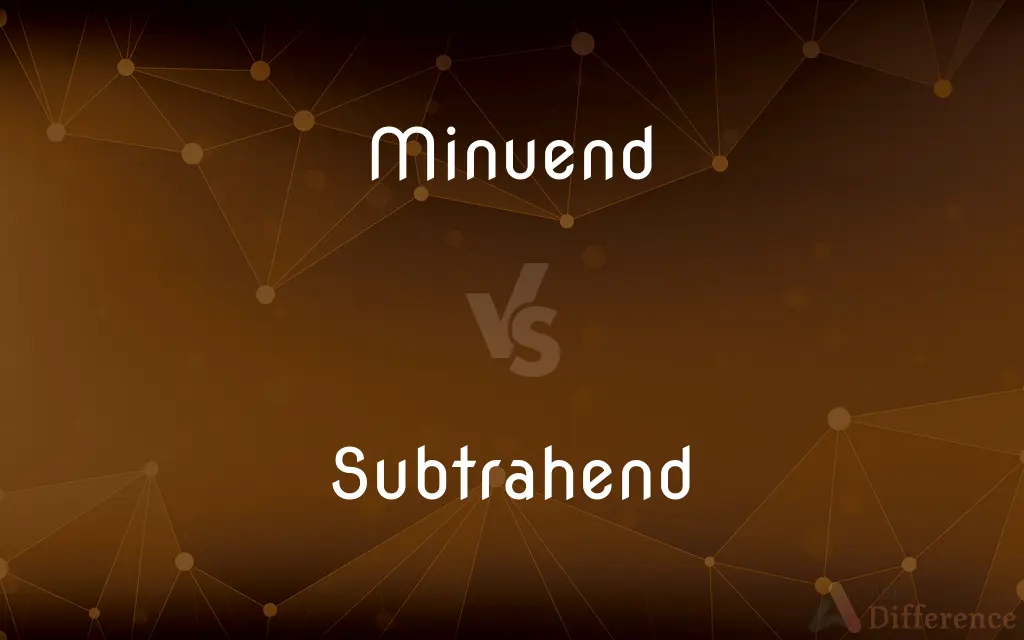Minuend vs. Subtrahend — What's the Difference?
By Tayyaba Rehman — Updated on October 6, 2023
In subtraction, the "Minuend" is the number from which another number (the "Subtrahend") is subtracted. Resulting difference = Minuend - Subtrahend.

Difference Between Minuend and Subtrahend
Table of Contents
ADVERTISEMENT
Key Differences
In arithmetic, subtraction involves two primary numbers: the Minuend and the Subtrahend. The process results in a difference, and understanding the roles of these two terms is essential for comprehending the operation.
The Minuend is the initial number, the one that is reduced or lessened by the subtraction process. Conversely, the Subtrahend is the number you subtract from the Minuend. Simply put, in the equation 7 - 5 = 2, 7 is the Minuend, and 5 is the Subtrahend.
While both terms are crucial for subtraction, their roles are distinct. The Minuend often represents the whole or starting quantity, while the Subtrahend represents the part you want to take away or deduct from the whole.
The relationship between Minuend and Subtrahend determines the result of the subtraction. If the Minuend is larger, the result is positive; if the Subtrahend is larger, the result is negative.
To master subtraction, one must have clarity on the roles of both the Minuend and the Subtrahend. While their distinction is simple, it's fundamental to accurate calculations.
ADVERTISEMENT
Comparison Chart
Definition
The number being subtracted from.
The number being subtracted.
Role in subtraction
Represents the whole or starting quantity.
Represents the part being deducted from the whole.
Example (in 7 - 5 = 2)
7
5
Position in the equation
Comes before the subtraction sign.
Comes after the subtraction sign.
Relation to result
The starting point for calculating the difference.
The quantity removed from the starting point.
Compare with Definitions
Minuend
The initial quantity in a subtraction operation.
In 15 - 6 = 9, 15 is the Minuend.
Subtrahend
The number which is subtracted from another in a subtraction operation.
In 9 - 2 = 7, 2 is the Subtrahend.
Minuend
The number that is to be reduced by another number.
Subtracting four from twelve means twelve is the Minuend.
Subtrahend
The number that indicates the amount to be subtracted.
If you want to leave 5 apples out of 8, 5 is the Subtrahend.
Minuend
The starting value in a subtraction equation.
When computing the change from a $20 bill for an $8 purchase, $20 is the Minuend.
Subtrahend
The bottom number in a vertical subtraction problem.
In column subtraction, the Subtrahend is the number written below the line.
Minuend
The top number in a vertical subtraction problem.
In columnar subtraction, the Minuend is the number written above the line.
Subtrahend
The quantity that is to be taken away from the Minuend.
Subtracting three from seven means three is the Subtrahend.
Minuend
The value from which another value is taken away.
If you eat 3 out of 10 cookies, 10 is the Minuend.
Subtrahend
The value being deducted in a subtraction equation.
When determining how much more one has than another, the lesser quantity is the Subtrahend.
Minuend
The quantity from which another quantity, the subtrahend, is to be subtracted. In the equation 50 - 16 = 34, the minuend is 50.
Subtrahend
A quantity or number to be subtracted from another.
Minuend
(arithmetic) A number or quantity from which another is to be subtracted.
In the subtraction 10 − 4, 10 is the minuend and 4 is the subtrahend.
Subtrahend
(arithmetic) A number or quantity to be subtracted from another.
In the subtraction 10 − 4, 4 is the subtrahend.
Minuend
In the process of subtraction{2}, the number from which another number (the subtrahend) is to be subtracted, to find the difference.
Subtrahend
The sum or number to be subtracted, or taken from another (the minuend) to find the difference.
Minuend
The number from which the subtrahend is subtracted
Subtrahend
The number to be subtracted from the minuend
Common Curiosities
Can the Minuend be smaller than the Subtrahend?
Yes, if the Minuend is smaller than the Subtrahend, the result is a negative number.
What is the role of the Minuend in subtraction?
The Minuend is the number from which the Subtrahend is subtracted.
In the equation 10 - 4 = 6, which is the Minuend?
In the equation 10 - 4 = 6, the Minuend is 10.
Which number is the Subtrahend in 12 - 5 = 7?
In 12 - 5 = 7, the Subtrahend is 5.
Why is understanding the Minuend and Subtrahend important?
It's essential for correctly performing and understanding subtraction operations.
How is the Minuend positioned in a vertical subtraction method?
In vertical subtraction, the Minuend is the number written on top.
Can both Minuend and Subtrahend have decimal values?
Yes, both numbers can be whole numbers, decimals, or fractions.
Can both the Minuend and Subtrahend be the same?
Yes, if they are the same, the difference is zero.
How does the Subtrahend affect the subtraction result?
The Subtrahend is the number being subtracted, determining the difference when taken from the Minuend.
Are Minuend and Subtrahend terms used in addition?
No, they are specific to subtraction; in addition, we use terms like "addends."
Is the Subtrahend always subtracted from the Minuend?
Yes, the Subtrahend is always the number taken away from the Minuend.
What is the result called after subtracting the Subtrahend from the Minuend?
The result is called the "difference."
Where is the Subtrahend placed in column subtraction?
In column subtraction, the Subtrahend is the number written below the Minuend.
What's the importance of the relationship between Minuend and Subtrahend?
Their relationship determines the difference, which is the outcome of the subtraction operation.
What happens when the Subtrahend is zero?
If the Subtrahend is zero, the difference remains the same as the Minuend.
Share Your Discovery

Previous Comparison
Manner vs. Culture
Next Comparison
Araised vs. RaisedAuthor Spotlight
Written by
Tayyaba RehmanTayyaba Rehman is a distinguished writer, currently serving as a primary contributor to askdifference.com. As a researcher in semantics and etymology, Tayyaba's passion for the complexity of languages and their distinctions has found a perfect home on the platform. Tayyaba delves into the intricacies of language, distinguishing between commonly confused words and phrases, thereby providing clarity for readers worldwide.














































